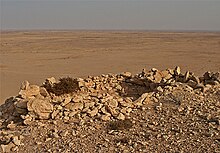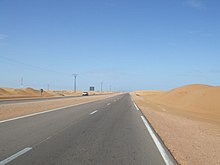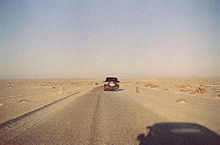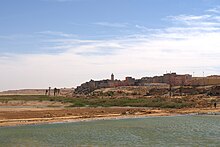Western Sahara is an area in North Africa bordering the Atlantic Ocean, between Mauritania and Morocco. Its governance is disputed between Morocco and the Sahrawi Arab Democratic Republic (SADR), but the majority of it is occupied by Morocco.
|
None of the content in this guide should be taken as a political endorsement of claims by either side in the dispute over the sovereignty of these territories. |
Cities

Under Moroccan administration
- El Aaiún (Laayoune)
- Al Mahbass
- Boujdour (Cape Bojador)
- Dakhla (Villa Cisneros)
- El Marsa
- Guelta Zemmur
- Haouza
- Smara
- Akhfennir
Under SADR administration
Under Mauritanian temporary administration
Other destinations
For those interested in sight-seeing, there are few opportunities for wildlife or natural formations other than the dunes. The area controlled by the Sahrawi Arab Democratic Republic (SADR)—known as the Free Zone or Liberated Territories—is of interest to those interested in the political conflict.
Understand
While there is a long coastline, much of it is rocky and not fit for beaches or travel. Large-scale fishing and ports are at Ad Dakhla. Much of the territory is arid desert.
The area to the immediate west of the sand wall (also known as "the berm") created by the Moroccan military is peppered by land mines and should be avoided. For political as well as health reasons, avoiding the berm is a wise decision regardless—it's nowhere near civilization and you can lose a limb in a heartbeat.
Administratively, the territory was divided by Spain into two regions: the northern strip, known as Saguia el-Hamra, and the southern two-thirds, named Río de Oro.
History

Morocco occupied and annexed the northern two-thirds of Western Sahara (formerly Spanish Sahara) in 1976, and much of the southern portion of the territory in 1979, following Mauritania's withdrawal. A guerrilla war with the liberation movement Polisario Front contesting Rabat's sovereignty ended in a 1991 cease-fire; a referendum on final status has been repeatedly postponed.
The Polisario declared the Sahrawi Arab Democratic Republic (SADR) in 1976, but the country has only been recognized by around 28 states and has actual control over only a largely uninhabited eastern slice of territory. Entry into this portion is only possible through Algeria.
People
Western Sahara's inhabitants, known as Sahrawis, are of Arab and Berber ethnicity and speak the Hassānīya dialect of Arabic. They are hospitable and known for their elaborate tea ceremonies.
Economy
Western Sahara depends on pastoral nomadism, fishing, and phosphate mining as the principal sources of income for the population. The territory lacks sufficient rainfall for sustainable agricultural production, and most of the food for the urban population must be imported. Virtually all trade and other economic activities are controlled by the Moroccan government. Moroccan energy interests in 2001 signed contracts to explore for oil off the coast of Western Sahara, a move that has angered Polisario and international observers. Incomes and standards of living in Western Sahara are substantially below the Moroccan level. Basic food items and gas are subsidized by the Moroccan government.
Climate
Western Sahara is a hot, dry desert; consequently, rain is rare, but flash floods occasionally occur. Cold offshore air currents produce fog and heavy dew. There is very little water in the ground. This coupled with a lack of water vapor in the air, which in other regions acts as a greenhouse gas, allows daytime heat to be lost very rapidly into space via infrared radiation. The result is harsh cold nights, despite the very high daytime temperatures.
Landscapes
Mostly low, flat desert, with large areas of rocky or sandy surfaces rising to small mountains in south and northeast. Low-lying sand dunes cover the territory.
If you are traveling overland, you will find no border formalities between Morocco and Western Sahara. Your passport may be asked for at the many checkpoints on the road south, but will not be stamped, as the Moroccan authorities regard the Western Sahara as part of Morocco.
Get in

The vast majority of Western Sahara is administered by Morocco, which considers it an integral part of its territory, so the same entry conditions apply as for Morocco itself. However, independent travel in the region is restricted, and while crossing through Western Sahara while traveling overland between Morocco and Mauritania is usually OK, some travellers have been turned back when trying to enter, especially during periods of political strife.
Official entry requirements for SADR-controlled areas are unclear, but in practice the area is entirely off-limits to visitors: you cannot legally cross the heavily guarded and mined Berm from the Moroccan-controlled side, the land border with Algeria is closed, and there are no legal border crossings from Mauritania into SADR-controlled territory either.
By plane
The only international airport is in El Aaiun, the capital. Flights come from the Canary Islands, Morocco and Spain. Other airports are located in Dakhla and Smara.
Note that even when arriving from Moroccan airports you will have to pass passport controls which are stricter than for entry into Morocco proper.
By train
There are currently no regular trains from El Aaiún to Marrakech, though a line is planned. Similarly, there is no train service between Agadir and El Aaiún.
By car
Travelling by car is probably one of the most convenient means of transport in Western Sahara, as public transport is rare to non-existent.
Entering (the occupied part of) Western-Sahara from the north (from Morocco, e.g. with a Moroccan rental car) on the main coastal highway N1 is fairly easy. From Tan-Tan onwards keep in mind to refuel regularly, even if still at 50%, because fuel stations will become sparse (distanced up to 200km and more). The same applies to the slightly less frequented road from Tan-Tan to Smara. Smara is notorious for land-mine incidents in the close vicinity of the town. The road from Assa via Zag to Al-Mahbes apparently has been closed for years, but was open between Assa and Zag as of early 2014. Continuing onwards to Al-Mahbes was denied by local authorities with reference to the frequent military operations, landmines and general security concerns. It needs to be kept in mind that Al-Mahbes is relatively close to Tindouf, the Polisario's headquarter and the refugee camps, which by itself possibly renders the region sensitive in the view of the Moroccan military. Moreoever, this region is rumoured to be possibly part of the operational area of AQIM.

Entering (the occupied part of) Western-Sahara from the South (Mauretania) involves passing through a few kilometers of Non-mans's Land, which is notorious for its landmines and allegedly also bandits (including false guides offering to guide you through the strip). Passing the strip requires prior knowledge of the track and should be done in full daylight. Do not be misled by the old tarmac road which you will cross: this is the so-called "Spanish Road", which dates back to the era of Spanish Sahara (the Spanish colony predating the declaring of independence in 1975) and leads to impassable sand dunes - and more hazardously: minefields - in both directions. Only a few meters of this road are still being in use today, which are close to the Mauretanian Border Post. Do not venture on this road any further than this. Deadly incidents have continued to occur over the last years as result of falsely interpreting the Spanish Road as the right track.
The Free Zone of Western Sahara - beyond the Berm - should be considered off-limits to any traveller. The gates in the Berm, which can be used by UN patrols, are not open to any other travellers. This being said, it may be theoretically possible to enter this region through either Algeria or Mauretania on existing tracks, but there are virtually no roads, so driving will be possible only with a 4×4 vehicle with high ground clearance. Several checkpoints through Mauritania are closed and there is a huge swathe of land mines along the berm. Driving within a few miles of it is extremely dangerous. The Sahrawis have been destroying land mines on their side of the berm, but the territory still has one of the highest concentrations of land mines in the world. This applies also to parts of the land being miles off the Berm, as can be seen e.g. on UN maps of minefields. The Free Zone of Western-Sahara, as well as the bordering parts of Algeria and Mauretania, are notorious for allegedly being used by various groups involved in all sorts of illegal activities. This includes AQIM, but also - and possibly more predominantly - organised crime, in particular trafficking of drugs and arms as a result of these lands being virtually uncontrolled by any government. The refugee camps have seen kidnappings of Westeners through Islamistic Groups in recent years.
By bus
Buses are present only in large metropolitan districts, such as El Aauin and Smara. There are direct services from Casablanca and Marrakech to Dakhla (running through Agadir, Tan Tan and Laayoune), frequent services run from Laayoune to major transport hubs in southern Morocco.
By boat
In 2010, a new passenger ferry was opened by Naviera Armas from Las Palmas de Gran Canaria in the Canary Islands to Laayoune but then suspended in Feb 2011.
Get around
By car
Especially for travel between cities you will need a car. Do be careful to refuel regularly, as gas stations can be very far apart and running out of fuel in the desert is a rather unpleasant experience.
Talk
The native language of the majority is Hassaniya Arabic, which is mutually unintelligible with Standard Arabic. Moroccan Arabic is also widely spoken, and is the lingua franca on the streets and the workplace because of the many Moroccans residing in the country. However, unlike in most Arab countries, Standard Arabic is not widely understood, and this applies even more for English, so without good knowledge of Hassaniya or Moroccan Arabic one will have to rely on hands, feet and smiles. People are generally very patient with people they don't share a language with and are also used to communicating with their hands and feet. Also the literacy level is much lower than that of Morocco, which is 50%, so you will have to speak rather than write. Some old signs are still written in Spanish. The Sahrawi population living in the refugee camps located in Algeria are over 90% literate, and some of the older Sahrawi generation still speak Spanish. As a consequence of Moroccan occupation, French can be used with a small business class.
See

- The Saharan desert, obviously.
- Remnants of the Spanish colonial rule in the capital El Aaiún.
- Many beautiful, completely unspoiled beaches that sometimes go on for miles.
Do
Buy
The Moroccan dirham is the official currency of the Moroccan-controlled portion, although the SADR has also minted its own pesetas.
Costs
Prices are lower than in Morocco, in part due to Moroccan government's subsidization policy.
Eat
With fishing being the main source of income for the local population, fish is the obvious choice: It is fresh and very cheap.
Drink
Traditional Sahrawi hospitality includes the serving of tea to all guests in one's home. Though, be aware, the tea is really strong, even for people used to high caffeine intake.
Stay safe
Hot, dry, dust/sand-laden sirocco wind can occur during winter and spring; widespread harmattan haze exists 60% of time, often severely restricting visibility. There are low-level uprisings and political violence which is altogether rare, but can escalate. Occupying powers are likely to evict foreigners in such case.
The N1 - and even more so the roads into the heart of the country - are very remote roads, with facilities and settlements being easily 150km to 200km away from each other. Take enough fuel (always refuel before going on the next leg, you never know what is going to happen) and enough water (several liters per person). Mobile network connection exists along N1.
Landmines and Unexploded ordnance (UXO)
Western Sahara saw war for over 15 years back in the 1970s and 1980s, and as a result, the landmine and UXO situation to this day remains quite unclear, despite efforts of the Moroccan Government to improve the situation. Most importantly to know is that landmines are not only in the remote parts of the country close to berm, but all the way down main coastal road (N1) to the Mauritanian border. Google Earth clearly shows the efforts to clear minefields all along N1, which continue to this day - despite Moroccan officers tending to tell tourists that this part of the country is safe. Around the settlements (Boujdour, Ad-Dakhla, Golfe de Cintra) the situation seems to be slightly worse, possibly due their strategic significance in the war. The warning signs are sometimes so rusty that they can't be recognised anymore, but usually the combination of two small metal signs is a strong indicator.

Keep eyes open to lines of stones, cairns, staples of old tyres and similar man-made marking - they are usually meaningful! Generally, any place off the tarmac-road of N1 and off-branching tarmac roads must be considered unsafe. Car-wrecks are strong indicators - do not explore these! Strategically significant points (the various small passes, narrow valleys, elevated points, etc.) are more dangerous, but this does not mean that other places are safe. Any man-made fortifications (straight sand-walls, round sand-wall [for artillery] and any other millitary looking movements of ground) pose particular danger (esp. south of Ad-Dakhla, but also south of Boujdour). It might be that these were mined when being abandoned to prevent them from falling into the other party's hand, or it might be that the surroundings were mined from the beginning to protect against guerrilla attacks, but anyway the mine-cleaning patterns strongly indicate that such places were and possibly continue to be particularly dangerous. Few to no mine-clearing efforts can be observed off the N1 - that possibly means that (i.a. for lack of touristic significance) these areas continue to be mined and efforts were focussed at the immediate surrounding of N1.
The patterns of cleaning mine-fields indicate that in not all cases does the Moroccan Government seem to be aware of the location of minefields, which requires more or less random search pattern. Moreover, on Google Earth it can be seen that where minefields have previously been cleared, new clearing activities have resumed later. This again indicates that even traces of cleared minefields do not guarantee safety. This includes the surroundings of the lagoon of Ad-Dakhla, including the lands north of it.
Stay healthy
No matter whether you travel in a private car or on a bus, always take enough water for at least 24 hours to be prepared if the vehicle breaks down.
Don't touch unknown vegetation - some of the seemingly good looking fruit one can find on the road side are poisonous even when just touched (one looks like miniature water melons, another like small cucumbers).
When climbing some of the rare stone formations, be aware of scorpions. Even though extremely rare, sometimes cobras are spotted (usually after a period of a few days with hot winds blowing to the West).
Respect
|
Ramadan Ramadan is the 9th and holiest month in the Islamic calendar and lasts 29–30 days. Muslims fast every day for its duration and most restaurants will be closed until the fast breaks at dusk. Nothing (including water and cigarettes) is supposed to pass through the lips from dawn to sunset. Non-Muslims are exempt from this, but should still refrain from eating or drinking in public as this is considered very impolite. Working hours are decreased as well in the corporate world. Exact dates of Ramadan depend on local astronomical observations and may vary somewhat from country to country. Ramadan concludes with the festival of Eid al-Fitr, which may last several days, usually three in most countries.
If you're planning to travel to Western Sahara during Ramadan, consider reading Travelling during Ramadan. |
The culture is Islamic but not particularly strict; the form of Islam that developed among the nomad population is non-mosque-based. Political and social displays of Sahrawi nationalism are violently repressed by the Moroccan police and military.
Connect
Teleboutiques and internet cafes are not hard to find in the cities, but connection speed may vary from place to place.


